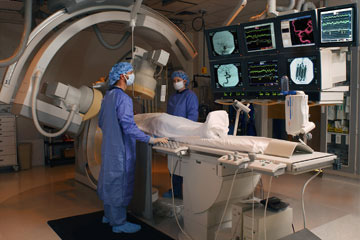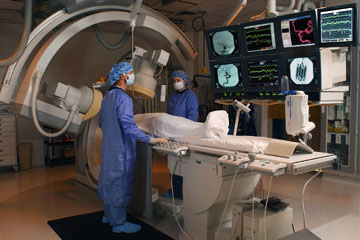
Neurointerventional biplane

The neurointerventional biplane is specifically designed for the diagnosis and treatment of neurological disorders, such as stroke and brain aneurysms. It has two-dimensional and three-dimensional capabilities that allow the neuroradiologist to view the brain, arteries and spine with one single injection of X-ray dye. In addition to being safer and faster than current technology, the biplane can reduce risk, length of stay and burden to a patient and family for many neurological disorders.

The neurointerventional biplane is specifically designed for the diagnosis and treatment of neurological disorders, such as stroke and brain aneurysms. It has two-dimensional and three-dimensional capabilities that allow the neuroradiologist to view the brain, arteries and spine with one single injection of X-ray dye. In addition to being safer and faster than current technology, the biplane can reduce risk, length of stay and burden to a patient and family for many neurological disorders.
The biplane, for example, allows physicians to intervene earlier with patients who are in the midst of a stroke, possibly preventing permanent damage and minimizing the long-term disability that typically accompanies stroke. Stroke continues to be the number one reason for admission to nursing homes and can devastate the lives of the patients and families who experience it. Between 75 percent and 80 percent of all strokes occur because of blockages in the arteries. Earlier intervention with the aid of the neurointerventional biplane technology can help prevent much of that damage.
In addition, the biplane can be used:
- To help physicians recreate the brain and its arteries in a 3-D model similar to virtual reality technology, allowing further study of the brain without exposing the patient to more radiation, injections and intervention,
- To repair brain aneurysms,
- During vertebral plasty procedures (bone cementing of crushed neck and back vertebrae), and
- During pediatric heart catheterization.
Our providers:
- James K. Goddard III, MD
- Jeffrey P. Lassig, MD
- Michael T. Madison, MD
- Thinesh Sivapatham, MD